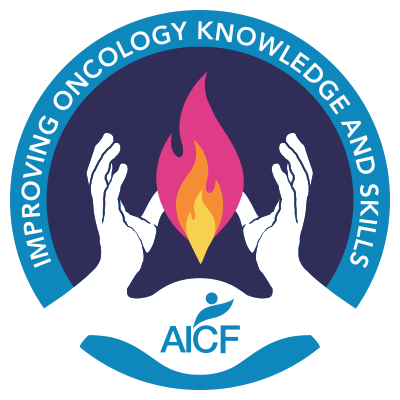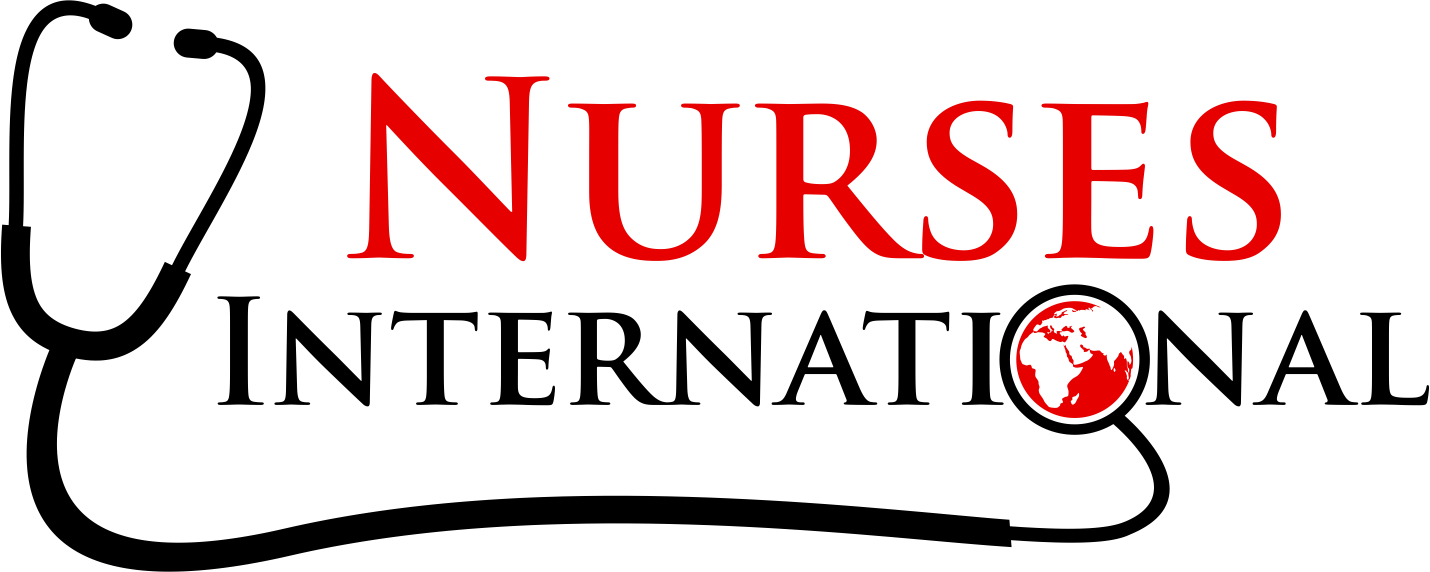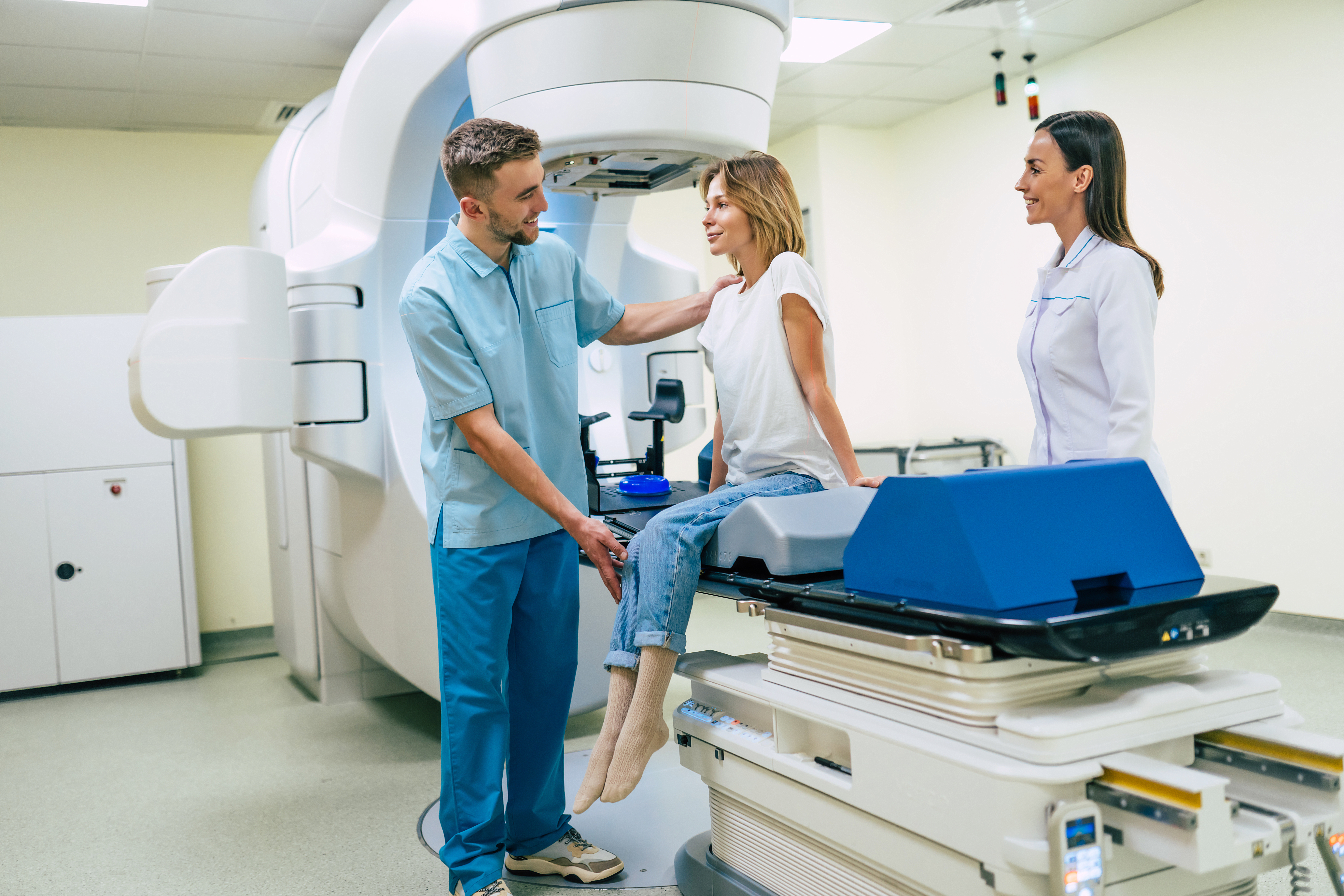-
GeneralGeneralTeachers
-
Oncology Nurse Homepage
DISCLAIMER: This content is designed to enhance the study of nursing. This content is generic and is not designed to take into account the specific objectives, needs, and/or circumstances of any particular region or country. To become a nurse, learners must successfully complete a program of study approved by the government or state-regulatory agency in their place of residence. We cannot guarantee that the successful completion of these materials will enable you to practice in your place of residence. Make sure that you are in compliance with the scope of practice of your regulatory body before attempting to put into use or practice any of the knowledge gained.

Introduction
This Oncology Nursing Course is designed to provide the learner with an understanding of cancer in the local, regional and global context and the need for nurses with specialized knowledge, skills, and attitudes to provide safe, competent, quality care to individuals.
The five (5) modules are designed to help nurses:
Deliver evidence-based information by enabling them to practice with accurate scientific knowledge, a solid nursing science foundation, excellent communication, and an understanding of the healthcare system for policy development as they work to prevent, identify, and treat patients with cancer.
Identify current treatments in interventional and pharmacological therapeutics with a focus on evidence-based holistic nursing care.
Place emphasis on the development of sound clinical judgment, critical thinking and collaborative care to achieve optimal outcomes for their patients.
Apply safeguards to support a safe practice environment for both patients and healthcare workers.
Identify basic concepts, growth and development considerations, nursing management strategies, stem cell knowledge, blood count interpretation, infection control, side effect management, nutrition, and age-appropriate communication techniques for pediatric oncology and hematology patients.
Approximate time for completion of this course is 167 hours at an average reading rate of 144 words/minute.



The Oncology Nursing course is sponsored by the Innovative Cancer Care Foundation (ICCF) and was developed in partnership with Nurses International (NI) and NextGenU.org (NGU). NextGenU.org courses are competency-based and use learning resources from accredited, world-class organizations such as the U.S. Centers for Disease Control and Prevention (CDC), the U.S. National Institutes of Health, the World Health Organization, the Pan American Health Organization, and International Guidelines, Universities, and peer-reviewed Journals. The Moodle Learning Management System (LMS) is utilized for facilitating distance learning. The course was designed by NextGenU’s Instructional Design team and Nurses International’s team members with particular thanks to Academic Director:Kathleen Capone EdD, CNE, MS, RN; Nurses International Faculty: Stacen Keating PhD, RN; Lillian A Donnelly MSN, RN NPD-BC; Lori Kerley, DNP, MS, RN; Caitlin M. Cartmell, MFS, BSN, RN; and Jordan Wilson, MSN, RN-BC; and oncology subject matter expert reviewers: Beth Hutchason MN, RN, AOCNP; Jennifer Thietz MSN, BSN, RN and Danielle Loumagne BMTCN, BSN, RN.
Last updated: 07/2024
Engaging with this course
- Nurse Educators may register to review all of the course content, and they may instruct students to register for this course by completing the registration form.
- Nurse Educators may contact NextGenU.org and request to use the platform with their students for free using the contact form.
- Begin the course with Module 1. For each lesson, read the description.
- Each lesson comprises introductory remarks. You may click on the collections of resources in each section.
- The Pediatric Oncology Module is offered as a separate course for learners who would like to focus their studies in that area.
- There is a final quiz to assess your understanding of important concepts. Click on the hyperlinks to take you to these items in each topic.
- This content is designed to enhance the study of nursing. To become a nurse, learners must successfully complete a program of study approved by the government or state-regulatory agency in their place of residence.
Requirements to obtain the certificateYou may browse this course for free for your personal enrichment. There are no requirements.
To obtain a certificate, a learner must successfully complete:
- all reading requirements
- all lessons quizzes
- all discussion forums
- the final exam with a minimum of 80% and a maximum of 2 attempts and
- the post-course survey, self, and course evaluation forms
Subscribe to our newsletter to be notified of future updates, new courses, and to be part of our community.
-
Module 1: The Science of Cancer
 This module introduces the learner to the basic physiologic characteristics of cancer biology including epidemiology and pathology, symptoms and disease processes, staging and grading, and incidence. An explanation of primary and secondary cancer prevention and treatment options including radiation, surgery, and use of antineoplastic agents, targeted therapies, and stem cell translations are included. Safe handling of chemotherapy agents along with the nurse’s role in providing safe patient care is explained.
This module introduces the learner to the basic physiologic characteristics of cancer biology including epidemiology and pathology, symptoms and disease processes, staging and grading, and incidence. An explanation of primary and secondary cancer prevention and treatment options including radiation, surgery, and use of antineoplastic agents, targeted therapies, and stem cell translations are included. Safe handling of chemotherapy agents along with the nurse’s role in providing safe patient care is explained.
-
Module 1: Lesson 1: Cancer Biology
Student Learning Outcomes:
- Describe the concepts of normal and cancer cell growth, proliferation, differentiation, and regulatory mechanisms.
- Define the characteristics of benign and malignant cells and tumors.
- Recognize the genetic, immunological, and hormonal basis of cancer.
- Describe processes of invasion and metastases.
- List common classification systems for cancer.
- Compare and contrast common methods for diagnosing, staging, and grading cancer.
15 URLs - Describe the concepts of normal and cancer cell growth, proliferation, differentiation, and regulatory mechanisms.
-
Module 1: Lesson 2: Cancer Treatment Planning
Student Learning Outcomes:
- Describe how classification of tumors influence treatment planning.
- Describe the individual related factors that influence cancer treatment planning.
- Discuss influence and use of cancer clinical trials in cancer treatment planning.
- Identify the principles for facilitating decision making by people affected by cancer.
- Define evidence-based guidelines.
- Identify evidence-based guidelines for cancer treatment planning.
Approximate time required for the readings for this lesson (at 144 words/minute): 1 hour and 5 minutes.5 URLs, 1 File, 1 Quiz - Describe how classification of tumors influence treatment planning.
-
Module 1: Lesson 3: Surgery in Cancer Treatment
Student Learning Outcomes:
- Describe the factors influencing the selection of surgery for cancer.
- Identify the types of surgery in the prevention, diagnosis, staging, treatment, and palliation of cancer.
- Identify upcoming surgery alternatives for cancer management.
- Explore nurse's role in surgical cancer treatment.
- Identify the impact of cancer surgery on various aspects of the patient's overall health.
- Discuss the prevention, detection, and management of common health alterations experienced by people undergoing surgery for cancer.
- Explore the nurse's role during pre and post-surgery for cancer.
Approximate time required for the readings for this lesson (at 144 words/minute): 1 hour and 3 minutes.10 URLs, 2 Quizzes -
Module 1: Lesson 4: Radiotherapy in Cancer Treatment
Student Learning Outcomes:
- Recognize the concepts of applied radiation physics and radiation biology.
- Describe the factors influencing the selection of radiotherapy for cancer.
- Discuss the role of radiotherapy in the treatment and palliation of cancer.
- List the methods for delivering radiotherapy.
- Describe the radiation safety principles to limit exposure to ionizing radiation for radiotherapy personnel, people affected by cancer, and the general public.
- Identify upcoming radiotherapy alternatives for cancer management.
- Identify the impact of radiotherapy on various aspects of the patients overall health.
- Describe the prevention, detection, and management of common health alterations experienced by people undergoing radiotherapy for cancer.
17 URLs, 2 Quizzes -
Module 1: Lesson 5: Antineoplastic Agents in Cancer Treatment
Student Learning Outcomes:
- Describe the classification of antineoplastic agents.
- Explain the role of antineoplastic agents in the treatment and palliation of cancer.
- Describe factors influencing the selection of antineoplastic agents for cancer.
- Compare the methods for administering antineoplastic agents.
- Describe the principles of safe handling of antineoplastic agents.
- Identify upcoming alternatives for antineoplastic therapies in the management of cancer.
- Describe the experience and impact of antineoplastic therapies on the patients overall health.
- Discuss the prevention, detection, and management of common health alterations experienced by people receiving antineoplastic therapies for cancer.
11 URLs, 2 Quizzes -
Module 1: Lesson 6: Targeted Therapies in Cancer Treatment
Student Learning Outcomes:
- Describe the role of targeted agents in the treatment and palliation of cancer.
- Define the classification of targeted therapies.
- Describe the factors influencing the selection of targeted therapies for cancer.
- Compare and contrast the methods for administering targeted therapies.
- Summarize the future directions in therapies on various health domains.
- Describe detection of common health alterations experienced by people receiving targeted therapies for cancer.
- Describe prevention of common health alterations experienced by people receiving targeted therapies for cancer.
- Describe the management of common health alterations experienced by people receiving targeted therapies for cancer.
Approximate time required for the readings for this lesson (at 144 words/minute): 2 hours and 52 minutes.18 URLs, 2 Quizzes -
Module 1: Lesson 7: Stem Cell Transplantation in Cancer Treatment
Student Learning Outcomes:
- Describe the hematological and immunological principles of hematopoietic stem cell transplantation (HSCT).
- Define donor histocompatibility.
- List the types of HSCT.
- Recognize diseases treatable by HSCT.
- Explain acute and chronic graft-versus-host disease.
- Explain the impact of HSCT on various health domains.
- Describe the prevention, detection, and management of common short and long term health alterations experienced by people undergoing HSCT.
15 URLs, 2 Quizzes - Describe the hematological and immunological principles of hematopoietic stem cell transplantation (HSCT).
-
Module 1: Lesson 8: Safe Handling of Hazardous Drugs
Student Learning Outcomes:
- Identify hazardous drugs related to cancer treatment.
- Describe the risk of exposure to hazardous drugs and its consequences.
- Describe use of personal protective equipment (PPE), spill cleanup and waste disposal of hazardous drugs in cancer treatment.
4 URLs, 2 Quizzes, 1 Forum -
Module 2: Nursing Care
This unit provides a comprehensive description of nursing management and care of the patient with cancer. It includes essential elements of education for the patient and family and addresses the principles of supportive and palliative care, death and dying and the nurse’s role in supporting the grief and bereavement processes. Nursing ethics and compliance consideration are included along with detailed description of treatment for oncologic emergencies.
-
Module 2: Lesson 1: Nursing Management of Tissue Integrity in Cancer Patient
Student Learning Outcomes:
- Identify cancer treatment procedures that affect skin integrity of the patient.
- Describe how skin integrity is assessed and cared for in cancer patients.
- Explain the concept of maintenance of tissue integrity for cancer patient in nursing care management and planning.
- Identify information for patient education/counselling on self-care related to skin integrity.
8 URLs, 1 Quiz -
Module 2: Lesson 2: Nursing Management of Nutrition in Cancer Patient
Student Learning Outcomes:
- Recognize the importance of promoting nutrition for the cancer patient in nursing care management and planning.
- Identify the main cancer treatment-related nutrition issues.
- Describe how well nutrition is assessed and addressed in cancer patients.
- Identify different nutrition therapy strategies in cancer patients.
- Identify information for patient education/counselling on self-care related to nutrition.
Approximate time required for the readings for this lesson (at 144 words/minute): 49 minutes.
5 URLs, 2 Quizzes, 1 Forum -
Module 2: Lesson 3: Nursing Management of Pain in Cancer Patient
Student Learning Outcomes:
- Define the concept and characteristics of pain in cancer care.
- Describe the classifications and mechanisms of pain of cancer patients.
- Describe pain assessment techniques and tools used in cancer care.
- Describe pharmacological pain management in cancer patients.
- Identify interventions for the management of side effects from pain medication in cancer patients.
- Identify non-pharmacological pain management in cancer patients.
- Identify information for patient education/counseling on pain management at home.
Approximate time required for the readings for this lesson (at 144 words/minute): 2 hours and 55 minutes.12 URLs, 3 Quizzes, 1 Forum -
Module 2: Lesson 4: Nursing Management of Fatigue and Weakness in Cancer Patient
Student Learning Outcomes:
- Define the fatigue and weakness normally experienced by cancer patients.
- Describe the methods to assess fatigue and weakness.
- Use methods of non-pharmacological and pharmacological interventions to address the fatigue generally experienced by cancer patients.
- Identify information for patient education/counselling on fatigue management at home.
4 URLs, 1 Forum, 1 Quiz -
Module 2: Lesson 5: Nursing Management of Self-esteem and Body Image Concerns in Cancer Patient
Student Learning Outcomes:
- Describe the definition of self-esteem and body image.
- Identify patient's concerns regarding body image and self-esteem as a consequence of cancer treatment.
- Discuss ways to improve body image and self-esteem in the nursing management of cancer patients.
- Identify information for patient education/counseling on self-esteem management and positive image at home.
3 URLs, 1 Quiz -
Module 2: Lesson 6: Nursing Management of Anemia in Cancer Patient
Student Learning Outcomes:
- Identify the common side effects of chemotherapy and radiation cancer therapies.
- Identify causes, signs/symptoms, and diagnostic factors of anemia in cancer patients.
- Describe the management of anemia in cancer patients.
- Describe the nurse's role in the management of anemia in cancer patients.
Approximate time required for the readings for this lesson (at 144 words/minute): 1 hour and 9 minutes
3 URLs, 1 Quiz -
Module 2: Lesson 7: Nursing Management of Thrombocytopenia/Bleeding in Cancer Patient
Student Learning Outcomes:
- Define thrombocytopenia.
- Identify causes, signs/symptoms, and diagnostic factors of thrombocytopenia and bleeding in cancer patients.
- Describe the management of thrombocytopenia/bleeding in cancer patients.
- Describe the nurse's role in the management of thrombocytopenia/bleeding in cancer patients.
5 URLs, 1 Quiz -
Module 2: Lesson 8: Nursing Management of Neutropenia and Mouth/Throat Problems in Cancer Patient
Student Learning Outcomes:
- Describe neutropenia and mouth/throat problems as side effects related to cancer and cancer treatment.
- Describe the management of these side effects.
- Describe the nurse's role in the management of these side effects.
Approximate time required for the readings for this lesson (at 144 words/minute): 51 minutes.
5 URLs, 1 Quiz -
Module 2: Lesson 9: Nursing Management of Extravasation and Peripheral Neuropathy in Cancer Patient
Student Learning Outcomes:
- Describe extravasation and peripheral neuropathy as side effects related to cancer and cancer treatment.
- Identify risk factors, signs, and symptoms of extravasation and peripheral neuropathy in cancer treatment.
- Describe the management of these side effects.
- Describe the nurse's role in the management of these side effects.
Approximate time required for the readings for this lesson (at 144 words/minute): 1 hour and 33 minutes.
8 URLs, 1 Quiz -
Module 2: Lesson 10: Patient Education
Student Learning Outcomes:
- Define patient education.
- Discuss nurse's role in provision of patient education.
- Identify benefits of patient education in cancer patients.
- Describe evidence-based approaches and process of patient education.
Approximate time required for the readings for this lesson (at 144 words/minute): 1 hour and 2 minutes.
5 URLs, 1 Quiz -
Module 2: Lesson 11: Supportive Care
Student Learning Outcomes:
- Define supportive care during and after cancer treatment.
- Describe the supportive care needs during and after cancer treatment.
- Identify the barriers to supportive care provision to cancer patients.
- Describe evidence-based screening and assessment approaches to identify supportive care needs.
- Explain the role of self-management as part of the supportive care process.
- Recognize self-care practices for nurses.
Approximate time required for the readings for this lesson (at 144 words/minute): 24 minutes.5 URLs, 1 Quiz -
Module 2: Lesson 12: Palliative Care
Student Learning Outcomes:
- Define palliative care.
- Discuss the role and benefits of palliative care.
- Identify the barriers to palliative care.
- Outline the requirements for having an effective care team in palliative care.
- Discuss the topic of pain management in palliative care.
- Identify the common psychosocial issues during end-of-life care of patients and their families.
4 URLs, 1 Quiz -
Module 2: Lesson 13: On Death and Dying
Student Learning Outcomes:
- Describe the role of spirituality and cross-cultural beliefs and practices surrounding death.
- Identify the various aspects of providing support and comfort to terminally ill patients.
- Recognize common emergencies in oncology.
- Describe actions to address common oncology emergencies.
- Describe nurse's role in end-of-life planning and Advanced Directives
- Provide insights on Legacy and Life Review Projects.
- Describe the nurse's role in respect to funeral practices, rituals, and legalities.
8 URLs, 1 Quiz -
Module 2: Lesson 14: Grief and Bereavement
Student Learning Outcomes:
- Describe the stages and expressions of grief.
- Identify the grieving process around cancer diagnosis, trajectory, and prognosis.
- Describe the importance of self-reflection in grief and bereavement management
- Identify resources and support networks to face the diagnosis, trajectory, and prognosis of cancer.
- Summarize the understanding on self-reflection on one's own mortality, myths, beliefs, and attitudes facing the death.
8 URLs, 1 Quiz -
Module 2: Lesson 15: Nursing Ethics
Student Learning Outcomes:
- Describe the main principles of Nursing practice ethics.
- Identify the provisions of the Nursing Code of Ethics specific guidance for nursing practice.
- Discuss the role and challenges of nursing ethics in oncology.
- Discuss the ethical issues and dilemmas that oncology nurses face in oncology nursing practice.
- Compare and contrast different ethical problem-solving strategies.
4 URLs, 1 Quiz - Describe the main principles of Nursing practice ethics.
-
Module 2: Lesson: 16. Scope of Nursing Practice
Student Learning Outcomes:
- Define the scope of nursing practice.
- Recognize the provision of nursing care within the scope of practice.
- Discuss the liabilities and limitations such as negligence and malpractice in the scope of nursing oncology practice.
- Identify the ethical considerations in the documentation and medical record-keeping.
- Identify the legal considerations in the documentation and medical record-keeping.
- Discuss the role of documentation and medical record-keeping in oncology nursing.
8 URLs, 1 Quiz - Define the scope of nursing practice.
-
Module 2: Lesson 17: Oncological emergencies - Cardiac Tamponade
Student Learning Outcomes:
- Explain the underlying pathophysiology of cardiac tamponade.
- Describe the scope of the problem including the incidence, etiology, and risk factors for this oncologic emergency.
- List the clinical manifestations that are associated with this emergency situation.
- Explain the nursing assessment for cardiac tamponade.
- List the nursing role to address cardiac tamponade in a timely and effective manner.
Approximate time required for the readings for this lesson (at 144 words/minute): 12 minutes.
3 URLs, 1 Quiz - Explain the underlying pathophysiology of cardiac tamponade.
-
Module 2: Lesson 18: Oncological emergencies_ Disseminated Intravascular Coagulation (DIC)
Student Learning Outcomes:
- Explain the underlying pathophysiology of Disseminated Intravascular Coagulopathy (DIC).
- Describe the risk factors associated with DIC.
- List the clinical manifestations (signs and symptoms) associated with DIC.
- Explain the nursing assessment for DIC.
- Characterize the nursing interventions and supportive care important to address this problem in a timely and effective manner.
Approximate time required for the readings for this lesson (at 144 words/minute): 20 minutes.
4 URLs, 1 Quiz - Explain the underlying pathophysiology of Disseminated Intravascular Coagulopathy (DIC).
-
Module 2: Lesson 19: Oncological Emergencies_ Hypercalcemia of Malignancy
Student Learning Outcomes:
- Explain the underlying pathophysiology of Hypercalcemia of Malignancy.
- Describe the scope of the problem including the incidence, etiology, and risk factors for this oncologic emergency.
- List the clinical manifestations that are associated with this emergency situation.
- Explain the nursing assessment including relevant diagnostic tests.
- Characterize the nursing interventions and supportive care important to address this problem in a timely and effective manner.
Approximate time required for the readings for this lesson (at 144 words/minute): 39 minutes.
3 URLs, 1 Quiz - Explain the underlying pathophysiology of Hypercalcemia of Malignancy.
-
Module 2: Lesson 20: Oncologic Emergencies- Septic Shock
Student Learning Outcomes:
- Explain the underlying pathophysiology of septic shock.
- Describe the scope of the problem including etiology and risk factors for this oncologic emergency.
- List the clinical manifestations that are associated with this emergency situation.
- Explain the nursing assessment for septic shock including relevant diagnostic tests.
- Characterize the nursing interventions and supportive care important to address this problem in a timely and effective manner.
6 URLs, 2 Quizzes, 1 Forum - Explain the underlying pathophysiology of septic shock.
-
Module:2 Lesson : 21: Nursing Management of Oncological Emergencies- Spinal Cord Compression
Student Learning Outcomes:
- Explain the underlying pathophysiology of Spinal Cord Compression.
- Describe the scope of the problem including the etiology and risk factors for this oncologic emergency.
- List the clinical manifestations that are associated with this emergency situation.
- Explain the nursing assessment for spinal cord compression including relevant diagnostic tests.
- Characterize the nursing interventions and supportive care important to address this problem in a timely and effective manner.
Approximate time required for the readings for this lesson (at 144 words/minute): 35 minutes.
4 URLs, 1 Quiz - Explain the underlying pathophysiology of Spinal Cord Compression.
-
Module 2: Lesson 22: Nursing Management of Oncological Emergencies- Increased Intracranial Pressure
Student Learning Outcomes:
- Explain the underlying pathophysiology of Increased Intracranial Pressure (ICP).
- Describe the scope of the problem including the etiology and risk factors for this oncologic emergency.
- List the clinical manifestations associated with this emergency situation.
- Explain the nursing assessment for ICP including relevant diagnostic tests.
- Characterize the nursing interventions and supportive care important to address this problem in a timely and effective manner.
Approximate time required for the readings for this lesson (at 144 words/minute): 24 minutes.4 URLs, 1 Quiz - Explain the underlying pathophysiology of Increased Intracranial Pressure (ICP).
-
Module 2: Lesson: 23 Nursing Management of Oncological Emergencies-Superior Vena Cava Syndrome
Student Learning Outcomes:
- Explain the underlying pathophysiology of Superior Vena Cava Syndrome.
- Describe the scope of the problem including the etiology and risk factors for this oncologic emergency.
- List the clinical manifestations that are associated with this emergency situation.
- Explain the nursing assessment for superior vena cava syndrome including relevant diagnostic tests.
- Characterize the nursing interventions and supportive care important to address this problem in a timely and effective manner.
Approximate time required for the readings for this lesson (at 144 words/minute): 13 minutes.3 URLs, 1 Quiz - Explain the underlying pathophysiology of Superior Vena Cava Syndrome.
-
Module 2: Lesson 24: Nursing Management of Oncological Emergencies-SIADH
Student Learning Outcomes:
- Explain the underlying pathophysiology of SIADH.
- Describe the scope of the problem including the incidence, etiology, and risk factors for this oncologic emergency.
- List the clinical manifestations that are associated with this emergency situation.
- Explain the nursing assessment for SIADH including relevant diagnostic tests.
- Characterize the nursing interventions and supportive care important to address this problem in a timely and effective manner.
Approximate time required for the readings for this lesson (at 144 words/minute): 26 mins.4 URLs, 1 Quiz - Explain the underlying pathophysiology of SIADH.
-
Module 2: Lesson 25: Oncological Emergency_ Tumor Lysis Syndrome
Student Learning Outcomes:
- Explain the underlying pathophysiology of Tumor Lysis Syndrome.
- Describe the scope of the problem including the incidence, etiology, and risk factors for this oncologic emergency.
- List the clinical manifestations that are associated with this emergency situation.
- Explain the nursing assessment for Tumor Lysis Syndrome including relevant diagnostic tests.
- Characterize the nursing interventions and supportive care important to address this problem in a timely and effective manner.
2 URLs, 1 Quiz - Explain the underlying pathophysiology of Tumor Lysis Syndrome.
-
Module: 2: Lesson: 26 Nursing Management of Oncological Emergencies- Hemorrhagic Cystitis
Student Learning Outcomes:
- Explain the underlying pathophysiology of hemorrhagic cystitis.
- Describe the scope of the problem including the incidence, etiology, and risk factors for this oncologic emergency.
- List the clinical manifestations that are associated with this emergency situation.
- Explain the nursing assessment for hemorrhagic cystitis including relevant diagnostic tests.
- Characterize the nursing interventions and supportive care important to address this problem in a timely and effective manner.
Approximate time required for the readings for this lesson (at 144 words/minute): 39 mins.4 URLs, 1 Quiz - Explain the underlying pathophysiology of hemorrhagic cystitis.
-
Module: 2 Lesson: 27: Nursing Management of Oncological Emergencies- Anaphylaxis
Student Learning Outcomes:
- Explain the underlying pathophysiology of Anaphylaxis.
- Describe the scope of the problem including the incidence, etiology, and risk factors for this oncologic emergency.
- List the clinical manifestations that are associated with this emergency situation.
- Explain the nursing assessment for Anaphylaxis including relevant diagnostic tests.
- Characterize the nursing interventions and supportive care important to address this problem in a timely and effective manner.
Approximate time required for the readings for this lesson (at 144 words/minute): 43 mins.5 URLs, 2 Quizzes, 1 Forum - Explain the underlying pathophysiology of Anaphylaxis.
-
Module 3: Enablers and Traits
 This unit addresses the skills the nurses need related to cancer prevention and treatment including effective communication, knowledge of change and conflict
management, and use of technology. The concepts of critical thinking and clinical judgment along with learning agility and self-care are introduced as essential skills needed by the oncologic nurse. The importance of cultural competence and the identification
of unconscious bias is introduced as key elements in nursing practice.
This unit addresses the skills the nurses need related to cancer prevention and treatment including effective communication, knowledge of change and conflict
management, and use of technology. The concepts of critical thinking and clinical judgment along with learning agility and self-care are introduced as essential skills needed by the oncologic nurse. The importance of cultural competence and the identification
of unconscious bias is introduced as key elements in nursing practice. -
Module 3: Lesson 1: Effective Communication
Student Learning Outcomes:
- Describe the fundamentals of communicating clearly and concisely, both orally and in writing.
- Summarize the principles of facilitation skills to help in decision making.
- Describe the learning needs of the adult learner
- Describe the principles to effectively teach virtual coaching/learning situations to inspire and engage team members.
- Use skills to effective coaching in individual and group situations to inspire and engage team members.
8 URLs, 1 Quiz -
Module 3: Lesson 2: Evidence Based Practice
Student Learning Outcomes:
- Define Evidence Based Practice (EBP).
- Discuss the significance of EBP to positive patient outcomes.
- Describe the components and process of EBP.
- Explain the role of nursing research in patient care.
10 URLs, 1 Quiz -
Module: 3 Lesson 3: Change Management
Student Learning Outcomes:
- Describe several change theories.
- Explain the change process.
- Describe what is meant by learning organizations
- Identify strategies to bring about change.
13 URLs, 1 Quiz -
Module 3: Lesson 4: Critical Thinking
Student Learning Outcomes:
- Define Critical Thinking, Clinical Reasoning, and Clinical Judgment.
- Identify the components of Critical Thinking.
- Explain the relationship of Critical Thinking, Critical Reasoning, and Clinical Judgment.
4 URLs, 1 Quiz -
Module 3: Lesson 5: Conflict Management
Student Learning Outcomes:
- Describe conflict management and its benefits in health workplace.
- Describe the optimal environment for dialogue in conflict management and resolution.
- Describe communication skills to manage a conflict taking into account the roles of those involved.
10 URLs, 1 Quiz -
Module 3: Lesson 6: Use of Technology
Student Learning Outcomes:
- Identify the significance of technology related to patient care.
- Describe various types of technology resources.
- Explore the elements of systematic inquiry.
- Describe the nurse’s role in the use of technology resources related to patient care and outcomes.
- Explore future trends in information technology in healthcare.
11 URLs, 1 Quiz -
Module 3: Lesson 7: Learning Agility
Student Learning Outcomes:
- Define learning agility.
- Describe the importance of learning agility in oncology nursing.
- Describe the dimensions of learning agility and the practices for assessing learning.
- Identify the capabilities needed to perform in a new situation.
4 URLs, 1 Quiz -
Module 3: Lesson 8: Self-Care
Student Learning Outcomes:
- Describe the concept of compassion fatigue, triggers, signs and symptoms, and treatment.
- Compare and contrast self-care practices that promote psychological and physical well-being.
- Describe stress management techniques such as yoga, meditation, mindfulness, journaling.
5 URLs, 1 Quiz - Describe the concept of compassion fatigue, triggers, signs and symptoms, and treatment.
-
Module 3: Lesson 9: Unconscious Bias - Conscious Inclusion
Student Learning Outcomes:
- Define Implicit and explicit bias.
- Describe the concept of implicit bias on the judgment and behavior of health practices.
- Recognize nursing's best practices to avoid and address the implicit biases.
7 URLs, 1 Quiz -
Module 4: Health Care Systems and Legislation
 This
unit provides an overview of the health care landscape within the local community and addresses how it affects nursing case management. Concepts related to nursing management and multidisciplinary team roles are
explored.
This
unit provides an overview of the health care landscape within the local community and addresses how it affects nursing case management. Concepts related to nursing management and multidisciplinary team roles are
explored. -
Module 4: Lesson 1: Health Care Landscape in South Africa
Student Learning Outcomes:
- Describe the South African healthcare system
- Describe how Medical Aid Schemes function.
- Define Prescribed Minimum Benefits.
- Define a “treatable” cancer.
1 URL - Describe the South African healthcare system
-
Module 4: Lesson 2: Nursing Case Management, Nurse Manager, and Multidisciplinary Team Roles
Student Learning Outcomes:
- Define case management.
- Describe the role of the Oncology Case Manager in a multidisciplinary team when caring for cancer patients.
- Describe the role of the Nurse Manager in a multidisciplinary team when caring for cancer patients.
- Describe the importance of a multidisciplinary team approach when caring for cancer patients.
Approximate time required for the readings for this lesson (at 144 words/minute): 4 hours and 7 minutes.
3 URLs, 1 Forum, 1 Quiz -
Module 5: Pediatric Oncology
This unit offers an overview of the care and management of pediatric patients with cancer and hematologic disorders, covering assessment, treatment modalities, specific cancers, emergencies, and holistic care, while emphasizing both medical and nursing management strategies to prepare healthcare professionals for the unique challenges of caring for children with cancer and their families.
-
Module 5: Unit 1: Overview Unit Objectives
Learning Unit Outcomes:
- Discuss the basic concepts related to pediatric oncology and hematology care.
- Apply knowledge of child growth and development to pediatric oncology and hematology patients.
- Interpret lab values and understand their implications for a child’s health status.
- Implement nursing management strategies based on assessing children and interpreting lab values.
- Apply concepts related to care, including understanding the hematopoietic stem cell chart, interpreting a CBC, implementing neutropenic precautions, and managing fevers.
-
Module 5: Unit 1: Lesson 1: Assessment of Children
Student Learning Outcomes:
- Assess the physical and emotional state of a child with cancer or a hematologic disorder.
- Identify signs and symptoms that may indicate changes in the child’s condition.
- Apply nursing management principles to plan and implement appropriate care based on the assessment findings.
2 URLs, 1 Quiz -
Module 5: Unit 1: Lesson 2: Growth and Development
Student Learning Outcomes:
- Identify the impact of cancer or a hematologic disorder on a child’s growth and development.
- Describe the developmental milestones and how they may be affected by disease or treatment.
- Identify nursing interventions to support average growth and development and address identified issues.
2 URLs, 1 Quiz -
Module 5: Unit 1: Lesson 3: Lab Values
Student Learning Outcomes:
- Interpret lab values and understand their implications for a child’s health status.
- Identify abnormal lab values that may indicate complications or side effects of treatment.
- Utilize nursing management strategies to monitor lab values and manage any identified issues.
2 URLs, 1 Quiz -
Module 5: Unit 1: Lesson 4: Risk of Infection and Neutropenic Precautions
Student Learning Outcomes:
- Explain the rationale for neutropenic precautions and the potential consequences of neutropenia.
- Describe how to implement neutropenic precautions to prevent infections in children with cancer or a hematologic disorder.
- Apply nursing management strategies to monitor for signs of infection and intervene.
2 URLs, 1 Quiz -
Module 5: Unit 1: Lesson 5: Management of Common Side Effects
Student Learning Outcomes:
- Describe the side effects and include cause and treatment and nursing management of the following common side effects of cancer treatment: Fevers; Skin concerns; Nausea and vomiting; Diarrhea and constipation; Fatigue; Knowledge deficit
2 URLs, 1 Quiz -
Module 5: Unit 1: Lesson 6: Nutrition and Hydration
Student Learning Outcomes:
- Discuss the significance of nutrition and hydration in children undergoing cancer treatment.
- Describe the causes of alterations in nutrition and hydration in children undergoing cancer treatment.
- Outline the nursing management and interventions related to nutrition and hydration in a child undergoing cancer treatment.
2 URLs, 1 Quiz -
Module 5: Unit 1: Lesson 7: Communication and Age-Specific Concerns in Pediatric Oncology
Student Learning Outcomes:
- Discuss the unique communication considerations of pediatric oncology patients at varying developmental stages.
- Describe how age influences the experience of pediatric oncology patients in terms of communication.
- Develop nursing interventions and strategies to support appropriate communication with pediatric oncology patients based on their age and developmental level.
2 URLs, 2 Quizzes -
Module 5: Unit 2: Treatment Modalities
Unit Learning Outcomes:
- Describe the various treatment modalities in pediatric oncology and hematology.
- Identify the impact of these treatments on the growth and development of pediatric patients.
- Evaluate the late effects of these treatments.
- Apply nursing management strategies in the care of pediatric patients undergoing these treatments.
-
Module 5: Unit 2: Lesson 1: Immunotherapy, Chemotherapy, Surgery and Radiation
Student Learning Outcomes:
- Describe the principles and mechanisms of immunotherapy, chemotherapy, surgery and radiation in pediatric oncology.
- Evaluate the effect of immunotherapy, chemotherapy, surgery and radiation on the growth and development of pediatric patients.
- Identify the potential late effects of immunotherapy, chemotherapy, surgery and radiation.
- Apply nursing management strategies in the care of pediatric patients undergoing immunotherapy, chemotherapy, surgery and radiation.
Approximate time required for the readings for this lesson (at 144 words/minute): 1 hour and 17 minutes.
2 URLs, 1 Quiz -
Module 5: Unit 2: Lesson 2: Stem Cell Transplant and Advanced Therapies
Student Learning Outcomes:
- Describe the principles and mechanisms of stem cell transplants and T-cell therapies in pediatric oncology.
- Explain the potential impact of these advanced therapies on the growth and development of pediatric patients.
- Identify the potential acute and late effects of these advanced therapies.
- Apply nursing management strategies in the care of pediatric patients undergoing these.
2 URLs, 2 Quizzes -
Module 5: Unit 3: Cancers in Childhood
Unit Learning Outcomes:
- Describe the definitions and presentations of pediatric leukemias and lymphomas.
- Identify the symptoms associated with pediatric leukemias and lymphomas.
- Discuss the medical management of pediatric leukemias and lymphomas.
- Outline the nursing management of pediatric patients with leukemias and lymphomas.
-
Module 5: Unit 3: Lesson 1: Leukemias and Lymphomas
Student Learning Outcomes:
a. Leukemias:
Approximate time required for the readings for this lesson (at 144 words/minute): 1 hour and 40 minutes.
i) Acute lymphoblastic leukemia
ii) Acute myeloid leukemia
b. Lymphomas:
i) Hodgkin lymphoma
ii) Non-Hodgkin lymphoma
2 URLs, 1 Quiz -
Module 5: Unit 3: Lesson 2: Solid Tumors
Student Learning Outcomes:
- Define and describe the presentation of common pediatric solid tumors, including medulloblastoma, gliomas, neuroblastoma, Wilms tumor, rhabdomyosarcoma, retinoblastoma, and Ewing sarcoma.
- Identify the symptoms associated with each of these pediatric solid tumors.
- Discuss the medical management of pediatric solid tumors.
- Outline the nursing management of pediatric patients with solid tumors.
2 URLs, 2 Quizzes -
Module 5: Unit 4: Pediatric Emergencies
Unit Learning Outcomes:
- Describe the following pediatric emergencies in children with cancer.
- Describe the medical management and the nursing management of pediatric oncologic emergencies.
-
Module 5: Unit 4: Lesson 1: Pediatric Emergencies
Student Learning Outcomes:
- Describe the following pediatric oncologic emergencies in children with cancer:
a. Tumor lysis syndrome
b. Febrile neutropenia
c. Increased intracranial pressure/brain herniation
d. Superior vena cava obstruction
e. Spinal cord compression
f. Hyperleukocytosis
g. Typhlitis
h. Malignant GI obstruction
i. Hypercalcemia
j. Posterior reversible encephalopathy syndrome
k. Cardiac tamponade l. disseminated intravascular coagulation - Discuss the medical management of each pediatric oncologic emergency listed above.
- Outline the nursing management for each pediatric oncologic emergency listed above.
2 URLs, 2 Quizzes - Describe the following pediatric oncologic emergencies in children with cancer:
-
Module 5: Unit 5: Hematologic Disorders
Unit Learning Outcomes:
- Describe the various hematologic disorders in pediatric patients.
- Identify the symptoms and presentation of these disorders.
- Define the medical management of these disorders.
- Apply nursing management and interventions in pediatric patients with hematologic disorders.
-
Module 5: Unit 5: Lesson 1: Red Blood Cell and Iron Disorders
Student Learning Outcomes:
- Describe the various red blood cell and iron disorders in pediatric patients, including:
a. Sickle cell disease
b. Anemias
c. Thalassemia
d. Iron deficiency anemia
e. Megaloblastic anemia
f. Hemolytic anemia
g. Hemochromatosis - Identify the symptoms and presentation of red blood cell and iron disorders mentioned above in pediatric patients
- Define the medical management of red blood cell and iron disorders mentioned above in pediatric patients
- Apply nursing management and interventions in pediatric patients with the red blood cell and iron disorders mentioned above
2 URLs, 1 Quiz - Describe the various red blood cell and iron disorders in pediatric patients, including:
-
Module 5: Unit 5: Lesson 2: Bleeding Disorders
Student Learning Outcomes:
- Describe the various bleeding disorders in pediatric patients, including:
a. Hemophilia
b. Von Willebrand Disease
c. Thrombocytopenia and platelet dysfunctions
d. Fibrinogen disorders - Identify the symptoms and presentation of bleeding disorders mentioned above in pediatric patients
- Define the medical management of the bleeding disorders mentioned above in pediatric patients
- Apply nursing management and interventions in pediatric patients with the bleeding disorders mentioned above
2 URLs, 1 Quiz - Describe the various bleeding disorders in pediatric patients, including:
-
Module 5: Unit 5: Lesson 3: Thrombosis and Coagulation Disorders
Student Learning Outcomes:
- Describe the various thrombosis and coagulation disorders in pediatric patients, including Inherited coagulation disorders and Thrombosis
- Identify the symptoms and presentation of the thrombosis and coagulation disorders mentioned above in pediatric patients
- Define the medical management of the thrombosis and coagulation disorders mentioned above in pediatric patients
- Apply nursing management and interventions in pediatric patients with the thrombosis and coagulation disorders mentioned above
2 URLs, 1 Quiz -
Module 5: Unit 5: Lesson 4: Autoimmune Blood Cell Disorders
Student Learning Outcomes:
- Describe the various autoimmune blood cell disorders in pediatric patients, including Immune thrombocytopenia and Autoimmune hemolytic anemia
- Identify the symptoms and presentation of the autoimmune blood cell disorders mentioned above in pediatric patients
- Define the medical management of the autoimmune blood cell disorders mentioned above in pediatric patients
- Apply nursing management and interventions in pediatric patients with the autoimmune blood cell disorders mentioned above
2 URLs, 1 Quiz -
Module 5: Unit 5: Lesson 5: Bone Marrow Failure Syndromes
Student Learning Outcomes:
- Describe the various bone marrow failure syndromes in pediatric patients, including Aplastic anemia and Myelodysplastic syndrome
- Identify the symptoms and presentation of the bone marrow failure syndromes mentioned above in pediatric patients
- Define the medical management of the bone marrow failure syndromes mentioned above in pediatric patients
- Apply nursing management and interventions in pediatric patients with the bone marrow failure syndromes mentioned above
2 URLs, 2 Quizzes -
Module 5: Unit 6: Holistic Care
Unit Learning Outcomes:
- Demonstrate comprehensive understanding and proficiency in providing holistic care to pediatric oncology patients and their families.
- Assess and manage pain effectively, utilizing various methods of pain management.
- Navigate ethical dilemmas commonly encountered in pediatric oncology care.
- Communicate empathetically with patients and families about end-of-life care decisions.
- Support families through pediatric oncology treatment challenges, providing emotional and educational support.
- Facilitate informed decision-making by patients and families regarding treatment options.
- Provide survivorship support, addressing both the long-term physical and psychological effects of pediatric cancer treatment.
- Address fertility preservation needs and discuss reproductive rights with patients and families.
- Integrate alternative and adjunctive therapies into patient care plans as appropriate.
-
Module 5: Unit 6: Lesson 1: Pain Management
Student Learning Outcomes:
- Identify common sources of pain in pediatric oncology patients.
- Describe the various methods of pain management
- Apply effective nursing interventions for pain management.
- Educate patients and families about pain management strategies.
2 URLs, 1 Quiz -
Module 5: Unit 6: Lesson 2: Palliative Care and End-of-Life
Student Learning Outcomes:
- Define the role of palliative care in pediatric oncology.
- Describe compassionate end-of-life care to pediatric oncology patients.
- Communicate effectively with patients and families about end-of-life decisions.
- Discuss ethics in end-of-life care
2 URLs, 1 Quiz -
Module 5: Unit 6: Lesson 3: Treatment of the Family
Student Learning Outcomes:
- Describe the impact of pediatric oncology on the family unit.
- Define the elements of supportive care and education to families of pediatric oncology patients.
- Discuss methods to facilitate family involvement in the child’s care.
2 URLs, 1 Quiz -
Module 5: Unit 6: Lesson 4: Ethical Concerns
Student Learning Outcomes:
- Identify and describe ethical issues commonly encountered in pediatric oncology (including Consent, Assent, and Dissent).
- Apply ethical principles in decision-making processes
- Describe how an ethics decision-making model can assist nurses in the care of pediatric clients and their families
- Advocate for the rights and best interests of pediatric oncology patients.
2 URLs, 1 Quiz -
Module 5: Unit 6: Lesson 5: Survivorship
Student Learning Outcomes:
- Describe the long-term physical and psychological effects of pediatric cancer treatment.
- Describe supportive care and education to pediatric cancer survivors.
- Discuss ways to facilitate the transition from active treatment to survivorship.
2 URLs, 1 Quiz -
Module 5: Unit 6: Lesson 6: Fertility Preservation
Student Learning Outcomes:
- Describe the impact of pediatric cancer treatment on future fertility.
- Discuss fertility preservation options with patients and families.
- Discuss the reproductive rights of pediatric oncology patients.
2 URLs, 1 Quiz -
Module 5: Unit 6: Lesson 7: Alternative and Adjunctive Therapies
Student Learning Outcomes:
- Define the role of alternative and adjunctive care in treating pediatric oncology patients.
- Describe various adjunctive therapies.
- Identify how various belief systems impact the care of children with cancer.
- Describe patient self-care activities and the use of spiritual and traditional healers.
- Describe the nurse’s role in the adaptation of care in managing varied health beliefs as they relate to a child with cancer.
2 URLs, 2 Quizzes -
Course and Self Evaluation & Certificate
 In this section, please provide feedback to help NextGenU.org improve its course offering. Once evaluations are completed, you will be able to download your certificate of completion.
In this section, please provide feedback to help NextGenU.org improve its course offering. Once evaluations are completed, you will be able to download your certificate of completion.


